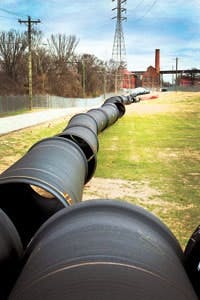A significant water main upgrade recently took place at the historic Omohundro Water Treatment Plant (WTP) in Nashville, Tenn.
Completed in late 2012, the upgrade required 5,760 ft of American (American Cast Iron Pipe Co.) ductile iron pipe—mostly 60-in. Lok-Ring restrained joint pipe—for a key water line leading from the Omohundro plant toward downtown Nashville. The new 60-in. main replaced twin cast-iron line that was installed in 1889 and 1927. American also supplied five 60-in. Series 2500 resilient wedge gate valves.
A Historical Site
The Omohundro WTP is among Nashville’s oldest landmarks and was listed on the National Register of Historic Places in 1987. Not only is it one of the nation’s oldest waterworks icons, but, for much of Nashville’s history, it was the city’s only facility of its kind.
Settlers of Nashville pumped water from a spring as early as 1826 to a public square reservoir through a water main made from hollowed locust and cedar logs. After fire destroyed that system, a new one was completed in 1833 and was used until what eventually became the Omohundro plant in 1889. Initially a pumping station, the Omohundro plant began treating water in 1928 and was the only such facility in Nashville until the K.R. Harrington WTP opened in 1978.
The Omohundro WTP became a household name in Nashville during the 2010 flood that rocked parts of the city. Floodwaters overran the K.R. Harrington facility, putting it out of service and leaving only the Omohundro plant operating. Buffeted with sandbags, the Omohundro plant narrowly escaped the floodwaters and was able to continue producing water.
A High-Profile Job
Following the flood, however, there were concerns about the Omohundro facility’s aging water mains, some of which were more than 120 years old.
“The [water main] project was a very high-profile job within our industry, and there were numerous stories in the local papers about it,” said David Bridge, a salesperson for Hayes Pipe and Supply, a regional waterworks distributor of American valves and hydrants founded in Nashville in 1973. “It was important that this job be done with as little disruption of water service as possible.”
Bridge acknowledged that Hayes Pipe and Supply was grateful that American makes a valve as large as 60 in. in diameter.
The Series 2500 60-in. resilient wedge gate valves were chosen for the job over butterfly valves and offered several basic advantages. Their unobstructed waterway allows better flow characteristics, which in turn provide a savings in pumping costs. The unobstructed waterway also allows for cleaning of the line with “pigging” devices.
The new water main ends at a tie-in to two existing 36-in. lines near the intersection of Lebanon Pike and Fesslers Lane. The Lok-Ring pipe features an essentially boltless restrained joint that incorporates the Fastite gasket for sealing. Restraint is provided by an alloy steel welded-on retainer ring and split Lok-Ring, which is assembled behind the retainer ring.
In addition to the pipe, American supplied 10 60-in. Lok-Ring bends; two 60-by-36-in. Lok-Ring/Flex-Ring reducers and eight welded-on outlets. Pipe products were sold to Kansas City, Mo.-based Garney Companies, general contractor for the project.
Additional valves for the project included four 36-in. and one 24-in. Series 2500 resilient wedge gate valve with mechanical joint ends, as well as assorted valves in smaller diameters and one American-Darling Mark 73-5 fire hydrant. All valves and hydrants were sold through Hayes Pipe and Supply.
According to Steve Ford, a Garney vice president based in Nashville, “[We have] maintained a strong strategic partnering relationship with American for almost 40 years, a relationship based on trust, respect, teamwork, and open and honest communication.”
The Omohundro plant is part of Metro Water Services, a department of the Metropolitan Government of Nashville and Davidson County. Metro Water Services has more than 176,000 water accounts and more than 189,000 sewer accounts in Davidson County and portions of Rutherford and Williamson counties. The distribution system consists of more than 2,800 miles of water main in diameters up to 60 in. The system has a capacity of 180 million gal per day, 140 million of it coming from the Omohundro plant.
Download: Here


